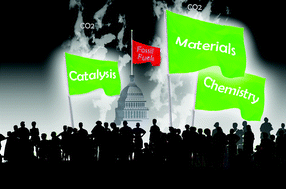You can't have an energy revolution without transforming advances in materials, chemistry and catalysis into policy change and action
Abstract
The central postulate of this perspective is that CO2 is not to be regarded as a combustion waste product of fossil fuel but rather to be considered as a chemical resource to be harvested and recycled to a renewable fuel using the power of the sun and the assistance of a catalyst. This vision reminds me of a prescient quote in a Life Magazine interview by Richard Buckminster Fuller, American philosopher, systems theorist, architect and inventor, who said: “Pollution is nothing but resources we're not harvesting. We allow them to disperse because we've been ignorant of their value. But if we got onto a planning basis, the government could trap pollutants in the stacks and spillages and get back more money than this would cost out of the stockpiled chemistries they'd be collecting”. In this context I have been pondering how the grand challenge faced by the materials research community of creating the science and technology to enable the transformation of CO2-to-fuel at a globally significant rate, efficiency and scale, necessary to help solve what looks like an insolvable global problem, is related to policy change and action?


 Please wait while we load your content...
Please wait while we load your content...